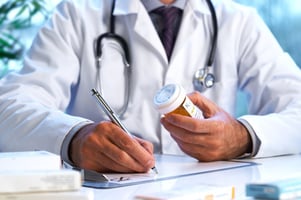By Joe Gerstein, M.D. – President, SMART Recovery Board of Directors

If there’s one message I would like to get across to those seeking and using prescription and/or street drugs in this day and age, it’s Buyer Beware!
Many know that prescription drugs – even with a prescription – come with the possibility of known warnings and side-effects. Abusing these prescription drugs increases the chance of experiencing these concerns, with the risk of addiction.
Getting street drugs – prescription or otherwise – has become increasingly dangerous. These street drugs are often tampered with – either laced with something harmful or replaced with something else completely. There’s really no telling what you’re getting when you make a purchase.
Addiction-related journals have recently provided at least one article per issue documenting the bizarre, and not infrequently, fatal effects of a batch of street or alternative-sourced drug(s). A recent news item involved 32 people in a park in Philadelphia who were found semiconscious or unconscious after apparent distribution of packets of someone’s concoction of a mind altering drug. Fortunately, no one succumbed. But not everyone is so lucky.
I encourage you to continue reading to get a better idea of how both prescription drugs and street drugs are tested (or “tested”) for safety.
My Medical Experience in Prescribing Drugs
I am no stranger to prescription drugs. I went into practice in 1967, and at least two of my 30 years in medical practice were spent explaining to patients the effects and, especially, the potential side-effects of prescription medication.
At that time, patients pretty much were willing to do what their doctor suggested in terms of medication.
Today, the cascade of medication information available on the web makes everyone an expert. Of course, the expression: “ask your doctor” really means “tell your doctor to prescribe this expensive new drug for your condition!”
To help patients in their efforts to become “experts,” let’s review how prescription drugs are tested and approved by the FDA.
How Prescription Drugs are Tested
The FDA requires drug manufacturers to submit at least two clinical trials documenting the efficacy of a drug and detailing all side-effects, even the trivial, as compared to the percentages detected in the placebo or the comparison drug. These are available on the so-called “Package Insert,” which originally was available only to physicians. Now it is widely available on the web and is often distributed with the drug at the pharmacy. Alternatively, a compilation of the information, minus the scientific gobbledygook, is handed out with the prescription.
The exact content and warnings about specific hazards are listed on the labels of so-called Over-the-Counter medications. The FDA has stringent requirements for purity and concentration of each component of prescription drugs. (e.g., the active component cannot vary more than +/- 20% from pill to pill, 10% for “narrow therapeutic index” medications, such as anti-seizure or cancer-treatment medications)
Generic drugs must closely duplicate not only the content of the active agent but also the approximate rate of release, distribution and decay. All manufacturing facilities, even overseas, are inspected periodically by the FDA, which requires exacting manufacturing standards and frequent batch testing for purity.
When there is a sufficiently-serious hazard involved, the FDA requires a “BLACK BOX” warning, which is printed on the package insert in bold type surrounded by a wide, black margin. When the hazard is so severe that special precautions have to be taken, FDA requires a an even more proscriptive Rare or Expensive Management [REM] program, which requires special training and monitoring of doctors and pharmacists.
You will notice, however, that the exhaustive list of possible toxic effects of the drug is spoken rapidly, usually with distracting graphics in the background. Even the word “death” is not avoided, when indicated. Apparently, these disclosures help to insulate the manufacturers from suits when catastrophic events occur.
How Street Drugs are “Tested”
Street drug dealers have their own – very different – testing methods, and they are not so scientific.
A recent National Geographic series on the Opioid Epidemic interviewed two IV drug users who received free bags of heroin from each new batch their dealer brought to town. If they survived, then the user could feel free to use or sell it.
In effect: human guinea pigs.
I don’t know whether he received a refund if they died or just cut the heroin a bit more.
Click here to read more about SMART Recovery’s approach to recovery.
A SMART Recovery Participant Story
A participant in one of my SMART Recovery meetings has a kratom problem she is trying to kick. She kicked her oxycontin habit about three years before, after her brother died of an overdose. But she then started buying kratom at local “smoke” shops and eventually got hooked. Kratom is supposed to have some mild opioid-like effects. It is made from the leaves of a tree that grows in South Asia.
When she heard of the death of her best friend, aged 25, after a presumed overdose, she decided again to get sober. She did well for several months, then got depressed and again bought some kratom. However, this batch seemed to make her more depressed, nervous, unable to sleep, nauseated and generally irritable and uncomfortable.
She blithely assumed that somehow she had become insensitive to the effects of the drug. She never considered the fact that perhaps there was no kratom in the package and/or that it was adulterated with another drug. She had no real knowledge whatsoever as to what was in that package.
From the outside looking in, it’s hard not to consider that the proverbial “400- pound man” filling packages at his mother’s kitchen table in Vietnam decided to use leaves that his brother had picked off a Banyan tree in the backyard (instead of kratom tree)!
Of course, her package was labeled, “Not For Human Consumption.”
Other Anecdotal Evidence of Our Drug Problem
Cocaine’s Newest Companion. Cocaine occasionally leads to an acute death; it’s likely that cardiac rhythm disturbance, myocardial infarction (heart attack) or massive stroke is to blame. This unfortunately happened to the Celtic’s first draft pick during a celebration of his success about 30 years ago. (As if getting picked first and a $6,000,000 bonus was not enough of a thrill.)
Cocaine today often comes with an added danger. Of the recent cocaine-associated deaths in a city, 80% of blood samples also tested positive for fentanyl, which is also currently lacing pretty much all street drugs.
Chemically-Created Drugs Cause Serious Side Effects. A recent Journal of Addiction Medicine article documented a case of “Flakka” ingestion – a highly potent and chemical bath salt – that resulted in acute psychosis and a condition called catatonia. Catatonia is typical of some severe cases of schizophrenia, in which person “freezes” in certain positions and becomes rigid – often being compared to a zombie. In the article, the horrific effects, plus hallucinations, continued for days.
My guess is these people did not expect these side effects when deciding to try flakka.
Sometimes Scientific Studies Fall Short. When scientists at Johns Hopkins initially studied the effects of psilocybin – the active psychedelic compound produced by more than 200 species of mushrooms – they did not purchase “shrooms” at the local smoke shop. They had it synthesized by chemists at Purdue University in order to be sure that there could be no contaminants confounding the results of the studies.
Just because the studies show one set of effects, that doesn’t mean that’s what you’ll experience! You don’t always know if something else has been added that could cause additional effects.
Rat Poisoning Cannabinoids? The FDA recently reported hundreds of cases of cannabinoid derivatives – often sold in gas stations and convenience stores under the label K2 or Spice – that have been laced with brodifacoum, an anticoagulant (blood-thinning) compound commonly used in rat poison. This anticoagulant is also used for people who have had blood clots in their veins, heart, etc. Apparently, this class of coumeral drugs inhibits the metabolism of the cannabinoids, therefore prolonging their effects. However, whoever “designed” this combination ignored the primary effect of this class of drugs: to prolong the time of clotting. In consequence of this action, there have been over 100 case reports of acute bleeding problems of various kinds, some life-threatening and one fatal: a spontaneous brain hemorrhage. Brodifacoum remains in the body a long time and can raise bleeding risk for weeks after consumption.
Users should seek medical attention if they believe to have consumed contaminated drugs. Click here to read the official statement on drugabuse.gov: https://www.drugabuse.gov/drugs-abuse/emerging-trends-alerts.
Conclusion
The evidence is plentiful. The drugs that people decide to put in their mouths, their noses and even their veins are stupefying and destructive, even when pure. The side effects of even carefully-vetted, FDA-authorized drugs are capable of causing a myriad of devastating issues – as is recited many times daily on TV commercials.
The stuff that is for sale at your local smoke shop is certainly not manufactured by Eli Lilly & Company or other pharmaceutical manufacturers. So, as the ancient Romans warned: “Caveat Emptor,” “ Let the Buyer Beware!!!”
– Joe Gerstein
About SMART Recovery USA
SMART Recovery’s 4-Point Program® helps people recover from all types of addictive behaviors, including: alcohol addiction, drug abuse, substance abuse, drug addiction, alcohol abuse, gambling addiction, cocaine addiction, and addiction to other substances and activities.
SMART Recovery sponsors face-to-face meetings around the world, and daily online meetings. In addition, our online message board and 24/7 chat room provide forums to learn about SMART Recovery and obtain addiction recovery support.
For more information, please visit www.smartrecovery.org.

